

Half Of All Western Europe's Population May Be Descended From Just One Man. The impact of innovation and technological advancement can be seen in the spread of humans around the world after the development of complex stone tools, or the explosion of industry during the industrial revolution.

But events like these in prehistory have not just left their mark in the physical record in the form of tools and bones, but it seems that traces of it can also be found in our DNA. A new study has revealed differing expansions of the male genetic line, which are seemingly linked to human development. Our hidden Neandertal DNA may increase risk of allergies, depression. Depressed?

Your inner Neandertal may be to blame. Modern humans met and mated with these archaic people in Europe or Asia about 50,000 years ago, and researchers have long suspected that genes picked up in these trysts might be shaping health and well-being today. Now, a study in the current issue of Science details their impact. It uses a powerful new method for scanning the electronic health records of 28,000 Americans to show that some Neandertal gene variants today can raise the risk of depression, skin lesions, blood clots, and other disorders. Blame Your Neanderthal Genes For Your Allergies. If you suffer from hayfever in spring or food allergies, you might want to blame a Neanderthal or Denisovan ancestor.

The interspecies mating that accounts for a small proportion of our genome has given some people a hyper-alert immune system, providing extra protection at the cost of overreacting to harmless pollen or foods. People of European descent have inherited between 1 and 6 percent of their genome from Neanderthals, although the circumstances under which the mating occurred remain unknown. In July, Dr. Michael Dannemann of the Max Planck Institute for Evolutionary Anthropology presented evidence at the Society for Molecular Biology and Evolution conference that this inheritance is particularly common in DNA controlling Toll-like receptors (TLRs), proteins that initiate the body's response to potential dangers.
Both Dannemann and Dr. All Blue-Eyed People Have This One Thing In Common. Every blue-eyed person on the planet is descended from a single European who lived around 6,000 to 10,000 years ago, and who first developed a specific mutation that accounts for the now widespread iris coloration.
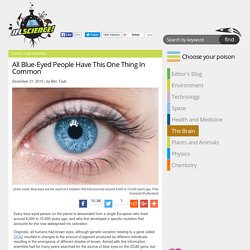
DNA - Episode 1 of 5: The Secret of Life - PBS Documentary. The Science Behind A More Meaningful Understanding Of Sexual Orientation. People who are attracted to others of the same sex develop their orientation before they are born.
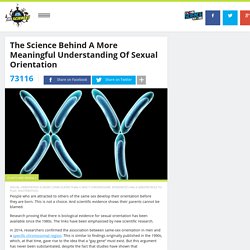
This is not a choice. And scientific evidence shows their parents cannot be blamed. Research proving that there is biological evidence for sexual orientation has been available since the 1980s. The links have been emphasised by new scientific research. In 2014, researchers confirmed the association between same-sex orientation in men and a specific chromosomal region. Luck Is A Bigger Factor In Cancer Development Than Lifestyle Or Genetics. Though genetic and lifestyle factors can play a significant role in the development of certain cancers, a new study has found that bad luck in mutating stem cells is the biggest risk factor for 2/3 of all cancers overall.
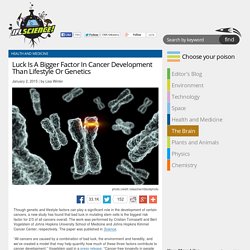
The work was performed by Cristian Tomasetti and Bert Vogelstein of Johns Hopkins University School of Medicine and Johns Hopkins Kimmel Cancer Center, respectively. The paper was published in Science. “All cancers are caused by a combination of bad luck, the environment and heredity, and we’ve created a model that may help quantify how much of these three factors contribute to cancer development,” Vogelstein said in a press release. When Did Humans Start To See The Color Blue? In the wake of the blue and black dress that gripped the internet last week, the topic of color perception has been weighing heavily on our collective minds.
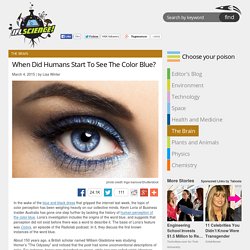
Kevin Loria of Business Insider Australia has gone one step further by tackling the history of human perception of the color blue. Loria's investigation includes the origins of the word blue, and suggests that perception did not exist before there was a word to describe it. The basis of Loria's feature was Colors, an episode of the Radiolab podcast. In it, they discuss the first known instances of the word blue. How Do Blue Eyes Get Their Color? When poets compare beautiful eyes to the sea or sky they're probably not aware how accurate they are being.
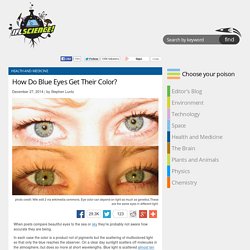
In each case the color is a product not of pigments but the scattering of multicolored light so that only the blue reaches the observer. On a clear day sunlight scatters off molecules in the atmosphere, but does so more at short wavelengths. Blue light is scattered almost ten times as effectively as red. As Paul Van Slembrouck explains in this Medium piece (with drawings) irises of people with blue eyes scatter the light back in the same way. If the light falling on the eye is white, that is contains a mix of wavelengths, it is mostly blue that will be reflected back for others to see. How Europeans evolved white skin. ST.

LOUIS, MISSOURI—Most of us think of Europe as the ancestral home of white people. But a new study shows that pale skin, as well as other traits such as tallness and the ability to digest milk as adults, arrived in most of the continent relatively recently. The work, presented here last week at the 84th annual meeting of the American Association of Physical Anthropologists, offers dramatic evidence of recent evolution in Europe and shows that most modern Europeans don’t look much like those of 8000 years ago.
The origins of Europeans have come into sharp focus in the past year as researchers have sequenced the genomes of ancient populations, rather than only a few individuals.
Face of Tomorrow. Hong Kong, China Ankara, Turkey Sydney University Avenida Paulista, Sao Paulo Copacabana, Rio de Janeiro Damascus, Syria Firenze Fiera, Florence Istanbul, Turkey Lima, Peru Koln Cathedral, Germany Los Leones, Santiago de Chile Tate Modern, London Praca Rossio, Lisbon Retiro Station, Buenos Aires Santo Amaro, Sao Paulo Santo Andre, Sao Paulo Super Composite Sao Paulo Super Composite Sydney Bondi Beach, Sydney Universidad Central del Ecuador Universidad de Navarra, Pamplona Spain.

Blue-eyed humans have a single, common ancestor. New research shows that people with blue eyes have a single, common ancestor. A team at the University of Copenhagen have tracked down a genetic mutation which took place 6-10,000 years ago and is the cause of the eye colour of all blue-eyed humans alive on the planet today. What is the genetic mutation "Originally, we all had brown eyes," said Professor Hans Eiberg from the Department of Cellular and Molecular Medicine. "But a genetic mutation affecting the OCA2 gene in our chromosomes resulted in the creation of a "switch," which literally "turned off" the ability to produce brown eyes. " The OCA2 gene codes for the so-called P protein, which is involved in the production of melanin, the pigment that gives colour to our hair, eyes and skin.
European genetic identity may stretch back 36,000 years. Europeans carry a motley mix of genes from at least three ancient sources: indigenous hunter-gatherers within Europe, people from the Middle East, and northwest Asians from near the Great Steppe of eastern Europe and central Asia. One high-profile recent study suggested that each genetic component entered Europe by way of a separate migration and that they only came together in most Europeans in the past 5000 years.
Genetic Markers: Connecting the Dots. 1. Introduce the activity and build students' background about genetic markers. Tell students that they are going to engage in a hands-on activity that simulates how genetic markers (also called genetic signposts) are passed on from one population of humans to another. Explain that mistakes occasionally happen when DNA is replicated, and that these mistakes can be passed from a person to his or her descendants. Information can get switched, dropped, or repeated. These mistakes are called mutations. 2. Select 2-3 students to be the scientists, and have them leave the room. 3. Call the scientists back into the room. 4. Scientists Identify Brain Expanding Gene In Humans. As humans, we know we are pretty unique: We are the most dominant species on Earth and our big brains are something worth boasting about. After all, they’re around three times larger than those of our closest relatives, chimpanzees, despite the fact that our DNA is 99% similar.
So to what do we owe this prominent feature? This question has been plaguing biologists for some time, but it seems we may be slowly starting to piece together this genetic puzzle. Just last week, scientists revealed that they had identified a stretch of DNA which, when inserted into mice, made their brains 12% larger than those with the same sequence from chimps.
Now, scientists have found a uniquely human gene that not only increased the size of a key brain region in mice, but also bestowed this area with the distinctive morphology observed in primate brains. The Neanderthal survival game.